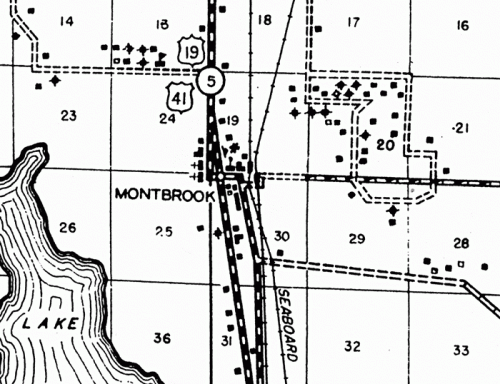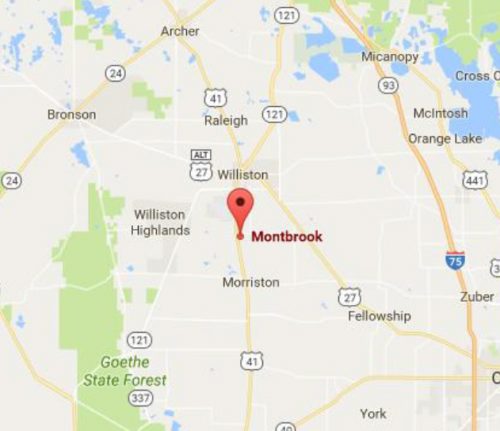Unsure of what name to give this new fossil site and with no special preference from the owners of the property, Vertebrate Paleontology’s Collection Manager, Richard Hulbert, began looking into the history of the area for anything interesting. He soon discovered an old line-drawn Florida Highway map of the area with the name ‘Montbrook’.

What is Montbrook? There are certainly no road signs for Montbrook that we have seen south of Williston along US Highway 41.
So, let’s start from the beginning…
Born on October 4, 1855, Montholen Brooks lived as a farmer in this area of eastern Levy County, Florida, south of Williston and north of Dunnellon. Levy County was named in honor of David Levy Yulee (a two-term US Senator and prominent business man) in 1845, 10 years before Brooks was born.
In 1877, Montholen married Mary Jane Plummer, whose family name is used for the local cemetery name, Plummer Cemetery, which today has a Williston, FL address. Montholen, Mary, and their nine children lived together in this area, which was eventually known as the town of Ambler. Ambler is the oldest municipality name recorded for the area and is most likely derived from the Ambler & Taliaferro Lumber Company, operated by D. C. Ambler, who was a lumber and timber baron and banker from Jacksonville.
Apparently, this was a time of great naming and territory disputes because the town was renamed ‘Phoenix Heights’ around 1891. Finally, on July 22, 1899, Montholen Brooks had the town renamed in his honor, combining parts of his first and last names. Montholen lived in Montbrook until the age of 74, Mary, until 84. They both, along with many members of their families, are buried in the Plummer Cemetery.
The 1911-1912 edition of the ‘Florida Gazetteer and Business Directory’, published by R. L. Polk & Company, stated that Williston at the time had a population of 400 and was known as one of the greatest cucumber farming districts in Florida. At the same time, the city of Montbrook had a larger population (481) and was known for its sawmills.
By the time of the publication of the 1918 edition of the Gazetteer, the population of Montbrook had increased to 500 and had more developments, including the Davis Hotel and various naval stores. However, by the 1925 edition, the population had dropped to 250 and the town had fewer businesses than previously listed. By the 1935-1936 Industrial Directory of Florida, there were no listings for Montbrook.
What happened?
Rumor has it that at some point a fire burned down the sawmills, which in turn, tore the town apart. Miss Emily Sneller was the last postmistress of the Montbrook Post Office until it was closed in the 1960s and mail operations in the area were transferred to the Williston Post Office. It appears that after this event, Montbrook no longer existed in an official capacity.
A memoir entitled “Reflections of a Rural Childhood” by G. Alan Brooks was published in 2011. He is a great-grandson of Montholen Brooks and grew up in the area that was once of Montbrook. According to G. Alan Brooks, the community of Montbrook is “where the farms were located” and was “the safest and the best place in the world to live”.

And now we are utilizing the name ‘Montbrook’ to designate our new and exciting, 5-million-year old, fossil site.
The Google map to the right proves that the name Montbrook still survives into the digital age of 2016! The name also remains known to some members of the community between Williston and Morriston, according to Catherine Mueller, a teacher at Williston High School who participated in a GABI-RET event that took place at our fossil site this past summer.
References:
Edited by: Richard Hulbert – August 13, 2020